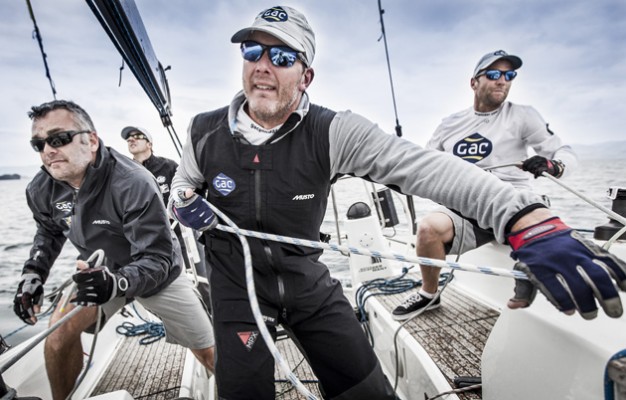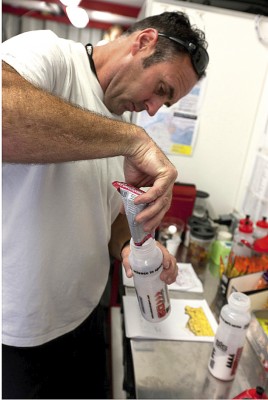Matthew Sheahan investigates the use of energy drinks on the racecourse and asks if they’re only for pros
From water bottles stuffed into cockpit rope bags to Mars bars tucked away in sailing jackets, food and drink on the move for many racing sailors hasn’t altered much over the years. Yet the science behind nutrition and hydration has changed, as has the physical and mental performance of those who have adopted a new scientific approach.
Step aboard any professionally run raceboat, from a Volvo 65 to an Olympic 49er, and the chances are each crewmember will have their own drinks bottle containing an opaque-looking fluid, as well as a bag of nuts or an energy bar to snack on. Some prefer natural foods and devour bananas and fig rolls between races, while others tear the top off a carbohydrate gel. For those requiring a quick mental jolt, caffeine chewing gum or ProPlus pills might finish off their refuelling stop in time for the next race.
Sports drinks and supplements are no longer simply the domain of the athletic elite. Today the market for rehydration drinks, energy bars and stimulants has grown rapidly and some of these products have now reached supermarket shelves.
But how effective are these new sporting products and do they really have a place aboard the typical weekend racer?
Hydration
Hydration is one of the biggest factors in improving your performance. According to experts, losing just two per cent of your body weight through dehydration can lead to a 20 per cent loss in athletic performance.
If you’re on the helm, or somewhere in the boat that is less physically demanding than, say, grinding and trimming, you may think that hydration is not really an issue. But you’d be wrong.
According to Dr Mark Tomson, a consultant for several key professional racing teams and events as well as an enthusiastic racing sailor, it is all too easy to underestimate the effects of dehydration.
“Dehydration affects our bodies in a number of ways, both in terms of mental and physical function. We may not think as fast, we may not be as co-ordinated and we may be slower in our movements,” he says. “When we are hung over, we accept this as normal and spend the next few hours drinking to help counteract the fluid deficiency. In these situations we are possibly one to two per cent dehydrated: for a 75kg person this means a deficit of about one and a half litres of fluid. A loss of two litres will significantly affect all our vital functions.
“A headache is very common when dehydrated and blood flow to muscles is probably less efficient, leading to a decrease in strength. The ability to sweat reduces, causing an unwelcome increase in body temperature. Even mood can be altered, reducing the mental drive to get up on deck and get on with things.”
But drinking pure water isn’t necessarily the answer, as during exercise the body will have sweated out vital salts and electrolytes. Indeed, drinking excessive quantities of water will dilute the sodium from your blood. Because water always follows salt, the water will move inside the cells towards the higher sodium concentration. This process is known as ‘water intoxication’ or hyponatraemia.
Popular rehydration drinks seek to address this, but vary in their make-up. Broadly speaking, the greater the sodium content the less palatable the drink. Sweetening the drink helps to mask the salty taste, but this introduces glucose and/or fructose, too much of which can cause upset stomachs.
“Generally we are looking at matching the salt content of a drink to the conditions our sailors are likely to experience,” says Paul Mullan, head of sports science and medicine for Team GBR. He continues: “The higher the potential for sweating at windy or hot venues, the higher the salt content required. For windy events we also look at including more carbohydrate in the drinks for energy.”
The number of rehydration drinks on the market has grown considerably in recent years, from ready-to-drink products such as Gatorade and Lucozade, to powders and tablets from manufacturers such as Science in Sport (SiS) and Zero. Among those that are commonly used, SiS’s Go Electrolyte, either in powder or tablet form, is one of the most popular. But new on the market is a rehydration powder from SOS Rehydrate. Backed by Sir Ben Ainslie, this product has more than double the amount of sodium than in a sports drink like Go Electrolyte, but by using natural additives has managed to mask the salty taste and has fewer calories.
But for all the products that are available off the shelf, there still are some who prefer to make their own rehydration drink.
“We make a mix of half natural orange juice, half water and a pinch of salt,” says paralympic Sonar sailor Hannah Stodel. “We sometimes have squash with a pinch of salt, or in my case I just drink Ribena.”
Carbohydrate is key
When it comes to energy levels, carbohydrate is the key. Again, powders are available that are mixed with water – some, such as SiS’s Go Energy, include a combination of electrolytes to rehydrate and carbohydrate for energy.
“Typically, the correct amount of carbohydrate to go for is around five per cent, around 50g per litre,” says sports physiotherapist and nutritionist Pete Cunningham. Formerly the head physiologist for the RYA, Cunningham developed a bespoke drink supplement for the British Olympic Team when it was preparing for Qingdao’s hot and humid conditions in 2008. He currently works for the Artemis America’s Cup team and Abu Dhabi Volvo race team.
“You can also use carb gels, but I think these are quite expensive given that they only provide around 20g of carbohydrate, the same as you would get in a banana,” he continues. “Some people eat fig rolls, which provide around ten grams of carbohydrate each. Having said that, the gels do work more quickly and for some people digesting food is difficult, particularly if they are stressed.”
Stimulants
The extra boost provided by an espresso coffee is of course well known ashore, but a strong coffee is not a convenient option aboard. Some sailors use caffeine chewing gum for a quick fix to jump start them back into action. Yet, as Paul Mullen explains, caffeine supplements are more of a personal choice.
“People’s tolerances to caffeine vary widely,” he says. “Some feel the lasting effects for hours on end while for others caffeine has little effect. It is easy to overdo caffeine intake, so we work with sailors on an individual basis for this.”
A widely tried product among sailors is a caffeine gum developed for the US military. Each portion of gum contains around 100g of caffeine, around the same as a single espresso.
“Generally, the gum doesn’t taste that good,” Mullen explains. “Caffeine gels and ProPlus tablets are used by some while others get a similar effect from drinking a flat can of Coke. Aside from the stimulants, when it comes to pills a lot of our sailors take Omega 3 fish oil supplements as part of their regular diet. Omega 3 is good for the cardiovascular system and is known to have an anti-inflammatory effect.
“One of the side effects of training at a high level is that it leaves you in a vulnerable state. You almost have to treat athletes as being sick as their immune systems are weakened. As a result their underlying diet is very important from the start.”
So while the science of nutrition and hydration has moved on and can provide benefits for any racing sailor, both physically and mentally, experts agree that supplements are just that and there is no substitute for a good core diet. Which is a problem for many of us when the beer tent is next door to the burger stall.
Sports supplements
HYDRATION
- SiS Go Electrolyte powder
- SOS Rehydrate powder
- High5 Zero hydration tablets
- Osmo Nutrition Active Hydration powder
ENERGY
- SiS Go Energy powder
- Gatorade G Series 02 Perform energy drink
- SiS Go Energy chew bar
- High5 Energy chew bar
- High5 Energy gel
- SiS Go Gel Isotonic energy gel
- Torq Energy gel
STIMULANTS
- SiS Go Caffeine energy gel
- ZipVit Sports ZV7
- Caffeinated energy gel
- Spearmint Military energy gum
Race-day diet for Olympic yachtsmen
by Team GB’s Paul Mullan
“A typical race-day diet for our sailors would begin with a carbohydrate breakfast around two hours before racing to top up the glycogen stores,” says Mullan, pictured below. “Then they might have a 500ml-1,000ml energy drink before they go out.
“Once on the water and generally between races they might eat an energy bar or take a carbohydrate gel. About 20g of carbohydrate will see them through approximately 30 minutes. Though if they’re working very hard they may need around 60-80g per hour.
“Although it is important to hydrate they have to be careful not to over drink, as it is possible to develop athlete gut syndrome where the high stress diverts blood to vital organs. This slows down digestion and leaves excess acidic drink lying in the stomach.
“After racing the supplements are more about repair and recovery. The body needs protein to repair and to avoid soreness later – there are plenty of ready-made drinks that usually contain whey protein. The key is to take them within 20 minutes of finishing exercise. You don’t need much though: a 200ml shake is easy to carry and can be drunk quickly.
“A Nesquik chocolate milkshake is a simple and effective drink. Once ashore they will often have another protein snack such as chicken or tuna, and rice.”
This is an extract from a feature in Yachting World August 2014 issue










